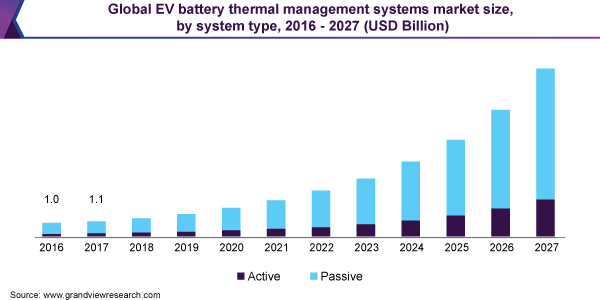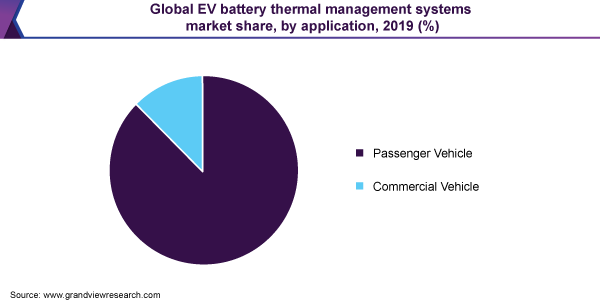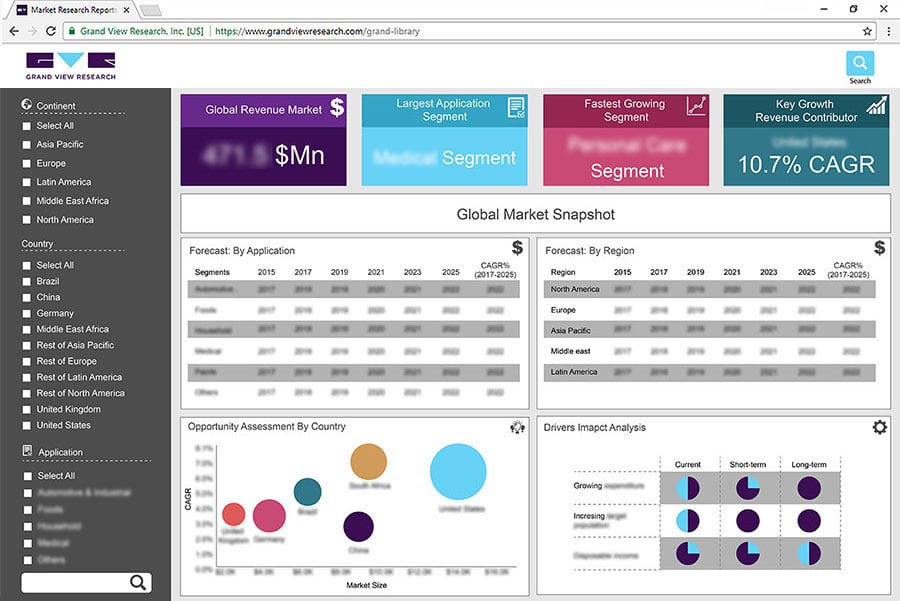- Home
- »
- Automotive & Transportation
- »
-
EV Battery Thermal Management Systems Market Report, 2027GVR Report cover
![Electric Vehicle Battery Thermal Management Systems Market Size, Share & Trends Report]()
Electric Vehicle Battery Thermal Management Systems Market Size, Share & Trends Analysis Report By Application (Passenger, Commercial), By System Type (Passive, Active), By Region, And Segment Forecasts, 2020 - 2027
- Report ID: GVR-4-68038-876-3
- Number of Report Pages: 80
- Format: PDF, Horizon Databook
- Historical Range: 2016 - 2019
- Forecast Period: 2020 - 2027
- Industry: Technology
Report Overview
The global electric vehicle battery thermal management systems market size was valued at USD 1.6 billion in 2019 and is expected to grow at a compound annual growth rate (CAGR) of 28.5% from 2020 to 2027. Increasing adoption of electric vehicles (EVs) across the globe is the primary factor driving the growth of this market. Countries, such as China, U.S., and Norway, have registered significant rise in the sales of EVs, which in turn, will contribute to the market growth.

Thermal management systems are required to maintain the adequate temperature range of the battery for effective functioning. Increasing penetration of battery-powered vehicles has pushed manufacturers to develop improved heat management systems for batteries. Reducing size of the batteries along with fast charging capabilities are hindering the market growth. However, technological advancements in the field of heat management for batteries are likely to support market expansion. Electric vehicles run on a battery and therefore offer limited operational range on a single charge.
This has motivated the battery manufacturers to develop products with fast charging capabilities. Fast charging of the battery generates more heat, which is required to be taken care of to prevent damage to the battery cells. Moreover, batteries are the single source to provide traction to the EVs, which results in high operating temperature of the batteries. Thus, automotive component manufacturers are focusing on developing advanced cooling methods to control the high temperatures of these batteries, which is expected to bolster the market growth in the coming years.
Various governments across the globe have established stringent carbon emission norms for vehicles. As a result, there has been a shift in the customer preference from Internal Combustion Engines (ICE) towards Battery Electric Vehicles (BEVs). In addition, Plug-in Hybrid EVs or PHEVs have also become popular globally as they run on both battery as well as IC engines.
On the other hand, the global coronavirus pandemic has highly impacted the manufacturing & production capabilities of organizations across industries, including automotive. As such, the current production rate of EVs has been largely deviated from the pre-Covid-19 forecasted figure for 2020. Furthermore, a global lockdown situation followed by falling demand for vehicles and supply chain disruptions is expected to hamper the market growth. However, various governments are taking initiatives to boost the economy and improve the infrastructure, which is anticipated to bolster the market growth over the forecast period.
System Type Insights
The passive system type led the global market and accounted for more than 78% of the overall revenue share in 2019. The segment is expected to continue its dominance over the coming years due to high demand for passive systems as they provide hundreds of watts of cooling and heating power.
Moreover, the cost associated with passive thermal management systems and its components is lesser as compared to the active cooling systems. The active type segment is expected to register the highest CAGR over the forecast period on account of the growing adoption of the systems that involve the use of air or liquid for cooling or heating the battery cells. Active battery thermal management systems (BTMS) increases battery life and efficiency.
Application Insights
The passenger vehicle segment held the largest market share of over 87% in 2019. The segment will retain the leading position expanding at the highest CAGR over the forecast period due to the easy availability of passenger EVs across the globe. In addition, several governments are taking initiatives to encourage the adoption of EVs, which is further driving the growth of this segment.

The commercial vehicle segment is expected to register a significant CAGR over the forecast period owing to the increased demand for battery-operated buses and lightweight trucks. For instance, as per the report issued by IEA, there was a stock of 460,000 electric buses and 250,000 light commercial vehicles (LCVs) in 2018, which were increased by around 80,000 units of LCVs from 2017. The increase in the number of battery-operated commercial vehicles can be attributed to the extraordinary savings in the running cost that EV provides. Although operating cost decreases to some extent which is motivating the use of EVs, the lower load capacity of these commercial vehicles may hinder the segment growth. However, technological developments coupled with better heat management systems are expected to help reduce the effect of this restraint.
Regional Insights
The Asia Pacific was the dominant regional market in 2019 and accounted for over 44% of the global revenue share. It is expected to grow further at the fastest CAGR over the forecast period. Countries, such as China and Japan, are the major contributors to the regional market. Increasing the adoption of EVs in the region, especially in China, is the major growth-driving factor. Moreover, growing consumer preference for EVs due to rising awareness about the benefits of these vehicles is expected to propel the regional market growth.
Europe's regional market is anticipated to witness significant growth over the forecast period owing to the presence of several key automobile and component manufactures, such as BMW, Fiat, Daimler AG, Volkswagen, Mercedes, and Volvo, in the region. Major contributors in the European market include Norway, Germany, France, The Netherlands, and U.K. Norway has the highest penetration of EVs worldwide and ranks third, in terms of EV sales, globally.
Key Companies & Market Share Insights
The market is moderately fragmented with the presence of several local companies. These market players are striving to gain higher market share by adopting strategies, such as investments, partnerships, and acquisitions & mergers. Companies are also spending on the development of improved battery cooling systems to aid better and lasting performance of the battery systems. Moreover, they are also focusing on maintaining competitive pricing.
Furthermore, the criticality of maintaining the average temperature range of the battery in EVs has forced the market players to develop newer ways of monitoring the real-time battery performance. For instance, in 2019, Robert Bosch GmbH announced a new cloud-connected battery management software service, which is designed to monitor and manage the status of electric batteries in EVs from a remote location. In addition, this will help in increasing the battery life by up to 20%. Some of the prominent players in the electric vehicle battery thermal management systems market include:
-
Robert Bosch GmbH
-
GENTHERM Incorporated
-
Valeo
-
Dana Incorporated
-
Mahle GmbH
-
Hanon Systems
-
Voss Automotive GmbH
-
3M
-
Grayson
-
Polymer Science, Inc.
-
Lord Corporation
Electric Vehicle Battery Thermal Management Systems Market Report Scope
Report Attribute
Details
Market size value in 2020
USD 2.0 billion
Revenue forecast in 2027
USD 12.1 billion
Growth Rate
CAGR of 28.5% from 2020 to 2027
Base year for estimation
2019
Historical data
2016 - 2019
Forecast period
2020 - 2027
Quantitative units
Revenue in USD million and CAGR from 2020 to 2027
Report coverage
Revenue forecast, company ranking, competitive landscape, growth factors, and trends
Segments Covered
System type, application, region
Regional scope
North America; Europe; Asia Pacific; Rest of the World (RoW)
Country scope
U.S.; Canada; U.K.; Germany; France; China; India; Japan; South Korea
Key companies profiled
Robert Bosch GmbH; Gentherm Incorporated; Valeo; Dana Incorporated; Mahle GmbH; Hanon Systems; Voss Automotive GmbH; 3M; Grayson; Polymer Science, Inc.; Lord Corporation
Customization scope
Free report customization (equivalent up to 8 analysts working days) with purchase. Addition or alteration to country, regional & segment scope.
Pricing and purchase options
Avail customized purchase options to meet your exact research needs. Explore purchase options
Segments Covered in the ReportThis report forecasts revenue growth at global, regional, and country levels and provides an analysis of the latest industry trends in each of the sub-segments from 2016 to 2027. For the purpose of this study, Grand View Research has segmented the global electric vehicle battery thermal management systems market report on the basis of system type, application, and region:
-
System Type Outlook (Revenue, USD Million, 2016 - 2027)
-
Active
-
Passive
-
-
Application Outlook(Revenue, USD Million, 2016 - 2027)
-
Passenger Vehicle
-
Commercial Vehicle
-
-
Regional Outlook (Revenue, USD Million, 2016 - 2027)
-
North America
-
U.S.
-
Canada
-
-
Europe
-
U.K.
-
Germany
-
France
-
-
Asia Pacific
-
China
-
India
-
Japan
-
South Korea
-
-
Rest of the World
-
Frequently Asked Questions About This Report
b. The global electric vehicle battery thermal management system market size was estimated at USD 1.67 billion in 2019 and is expected to reach USD 2.1 billion in 2020.
b. The global electric vehicle battery thermal management system market is expected to grow at a compound annual growth rate of 28.5% from 2020 to 2027 to reach USD 12.1 billion by 2027.
b. The Asia Pacific dominated the electric vehicle battery thermal management system market with a share of 44.6% in 2019. This is attributable to the higher adoption of electric vehicles in Asia Pacific countries, especially China.
b. Some key players operating in the electric vehicle battery thermal management system market include Robert Bosch GmbH, Gentherm Incorporated, Valeo, Hanon Systems, Mahle GmbH, Dana Limited, Voss Automotive GmbH, Grayson, 3M, Polymer Science, Inc., and Lord Corporation.
b. Key factors that are driving the market growth include the increasing adoption rate of the electric vehicle across the globe and the growing need to develop fast-charging batteries that generate more heat.
Share this report with your colleague or friend.
![gvr icn]()
NEED A CUSTOM REPORT?
We can customize every report - free of charge - including purchasing stand-alone sections or country-level reports, as well as offer affordable discounts for start-ups & universities. Contact us now
![Certified Icon]()
We are GDPR and CCPA compliant! Your transaction & personal information is safe and secure. For more details, please read our privacy policy.
We are committed towards customer satisfaction, and quality service.
"The quality of research they have done for us has been excellent."





